Reactor 操作符
数据在响应式流中的处理,就像流过一条装配流水线。Reactor 既是传送带,又是一个个的装配工或机器人。原材料从源头(最初的 Publisher )流出,经过一个个的装配线中装配工或机器人的工位加工(operator 操作),最终被加工成成品,等待被推送到消费者( subscribe 操作)。
在 Reactor 中,每个操作符对 Publisher 进行处理,然后将 Publisher 包装为另一个新的 Publisher 。就像一个链条,数据源自第一个 Publisher ,然后顺链条而下,在每个环节进行相应的处理。最终,订阅者(Subscriber )终结这个过程。所以, 响应式编程按照链式方式进行开发。
注意,如同 Java Stream 的终端操作,订阅者( Subscriber )在没有订阅( subscribe )到一个发布者( Publisher )之前,什么也不会发生。
如同 Java Stream 的中间操作一样,Reactor 的 Flux 和 Mono 也为我们提供了多种操作符(远多于 Stream ),我们将它们分类如下:
| 序号 | 类型 | 操作符 |
|---|---|---|
| 1 | 转换 | as, cast, collect, collectList, collectMap, collectMultimap, collectSortedList, concatMap, concatMapDelayError, concatMapIterable, elapsed, expand, expandDeep, flatMap, flatMapDelayError, flatMapIterable, flatMapSequential, flatMapSequentialDelayError, groupJoin, handle, index, join, map, switchMap, switchOnFirst, then, thenEmpty, thenMany, timestamp, transform, transformDeferred |
| 2 | 筛选 | blockFirst, blockLast, distinct, distinctUntilChanged, elementAt, filter, filterWhen, ignoreElements, last, next, ofType, or, repeat, retry, single, singleOrEmpty, sort, take, takeLast, takeUntil, takeUntilOther, takeWhile |
| 3 | 组合 | concatWith, concatWithValues, mergeOrderWith, mergeWith, startWith, withLatestFrom, zipWith, zipWithIterable |
| 4 | 条件 | defaultIfEmpty, delayUntil, retryWhen, switchIfEmpty |
| 5 | 时间 | delayElements, delaySequence, delaySubscription, sample, sampleFirst, sampleTimeout, skip, skipLast, skipUntil, skipUntilOther, skipWhile, timeout |
| 6 | 统计 | count, reduce, reduceWith, scan, scanWith |
| 7 | 匹配 | all, any, hasElement, hasElements |
| 8 | 分组 | buffer, bufferTimeout, bufferUntil, bufferUntilChanged, bufferWhen, groupBy, window, windowTimeout, windowUntil, windowUntilChanged, windowWhen, windowWhile |
| 9 | 事件 | doAfterTerminate, doFinally, doFirst, doOnCancel, doOnComplete, doOnDiscard, doOnEach, doOnError, doOnNext, doOnRequest, doOnSubscribe, doOnTerminate, onBackpressureBuffer, onBackpressureDrop, onBackpressureError, onBackpressureLatest, onErrorContinue, onErrorMap, onErrorResume, onErrorReturn, onErrorStop |
| 10 | 调试 | checkpoint, hide, log |
| 11 | 其它 | cache, dematerialize, limitRate, limitRequest, materialize, metrics, name, onTerminateDetach, parallel, publish, publishNext, publishOn, replay, share, subscribeOn, subscriberContext, subscribeWith, tag |
接下来我们来挨个学习各类的操作符,如同前面学习响应式流创建一样,讲解操作符时,如果是 Flux 或 Mono 独有的,会在方法名前增加类名前缀。
转换类操作符
转换类的操作符数量最多,平常过程中也是使用最频繁的。
as
将响应式流转换为目标类型,既可以是非响应式对象,也可以是 Flux 或 Mono。
Flux.range(3, 8)
.as(Mono::from)
.subscribe(System.out::println);
cast
将响应式流内的元素强转为目标类型,如果类型不匹配(非父类类型或当前类型),将抛出 ClassCastException ,见图知意:
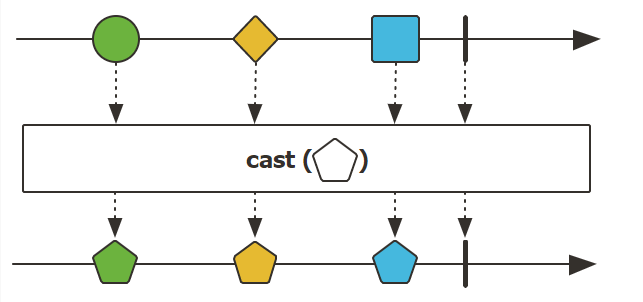
Flux.range(1, 3)
.cast(Number.class)
.subscribe(System.out::println);
Flux#collect
通过应用收集器,将 Flux 发出的所有元素收集到一个容器中。当此流完成时,发出收集的结果。 Flux 提供了 2 个重载方法,主要区别在于应用的收集器不同,一个是 Java Stream 的 Collector, 另一个是自定义收集方法(同 Java Stream 中 collect 方法):
<R,A> Mono<R> collect(Collector<? super T,A,? extends R> collector);
<E> Mono<E> collect(Supplier<E> containerSupplier,
BiConsumer<E,? super T> collector);
见图知意:
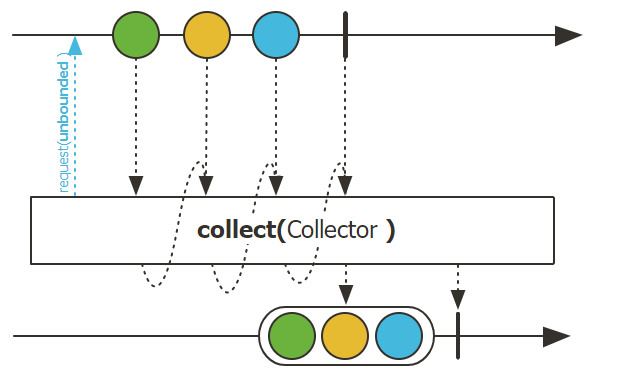
Flux.range(1, 5)
.collect(Collectors.toList())
.subscribe(System.out::println);
Flux#collectList
当此 Flux 完成时,将此流发出的所有元素收集到一个列表中,该列表由生成的 Mono 发出。见图知意:
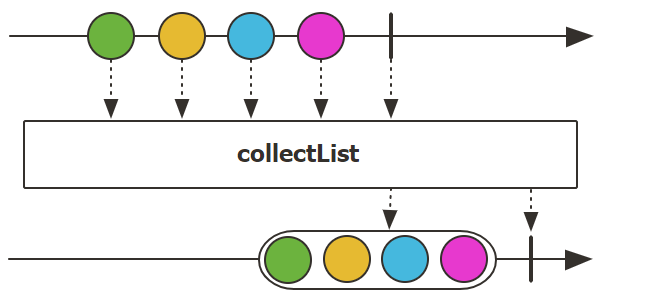
Flux.range(1, 5)
.collectList()
.subscribe(System.out::println);
Flux#collectMap
将 Flux 发出的所有元素按照键生成器和值生成器收集到 Map 中,之后由 Mono 发出。Flux 提供了 3 个重载方法:
<K> Mono<Map<K,T>> collectMap(Function<? super T,? extends K> keyExtractor);
<K,V> Mono<Map<K,V>> collectMap(Function<? super T,? extends K> keyExtractor,
Function<? super T,? extends V> valueExtractor);
<K,V> Mono<Map<K,V>> collectMap(Function<? super T,? extends K> keyExtractor,
Function<? super T,? extends V> valueExtractor,
Supplier<Map<K,V>> mapSupplier);
它们的主要区别在于是否提供值生成器和初始的Map,意同 Java Stream 中的 Collectors#toMap 。见图知意:
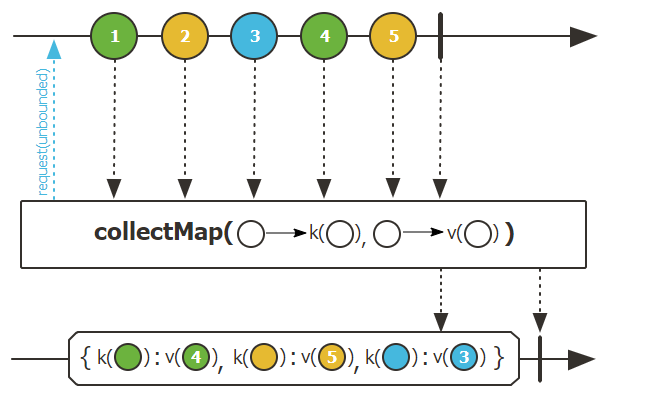
Flux.just(1, 2, 3, 4, 5, 3, 1)
.collectMap(n -> n, n -> n + 100)
.subscribe(System.out::println);
Flux#collectMultimap
collectMultimap 与 collectMap 的区别在于,map 中的 value 类型不同,一个是集合,一个是元素。 collectMultimap 对于流中出现重复的 key 的 value,加入到了集合中,而 collectMap 做了替换。在这点上,reactor 不如 Java Stream 中的 Collectors#toMap 方法,没有提供 key 重复时的合并函数。也提供了 3 个重载方法。
<K> Mono<Map<K,Collection<T>>> collectMultimap(Function<? super T,? extends K> keyExtractor);
<K,V> Mono<Map<K,Collection<V>>> collectMultimap(Function<? super T,? extends K> keyExtractor,
Function<? super T,? extends V> valueExtractor);
<K,V> Mono<Map<K,Collection<V>>> collectMultimap(Function<? super T,? extends K> keyExtractor,
Function<? super T,? extends V> valueExtractor,
Supplier<Map<K,Collection<V>>> mapSupplier)
见图知意:
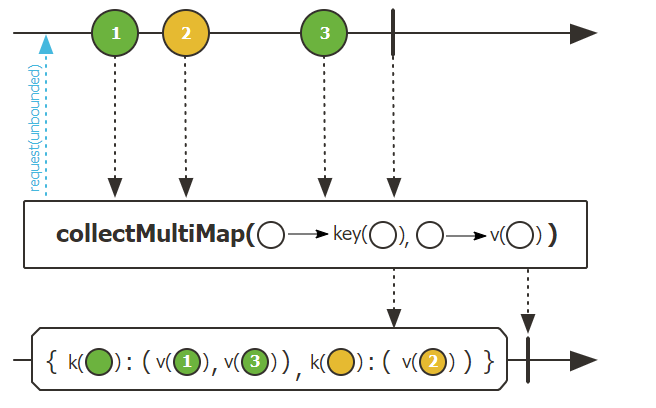
Flux.just(1, 2, 3, 4, 5, 3, 1)
.collectMultimap(n -> n, n -> n + 100)
.subscribe(System.out::println);
Flux#collectSortedList
将 Flux 发出的元素在完成时进行排序,之后由 Mono 发出。Flux 提供了 2 个重载方法:
Mono<List<T>> collectSortedList();
Mono<List<T>> collectSortedList(@Nullable Comparator<? super T> comparator);
见图知意:
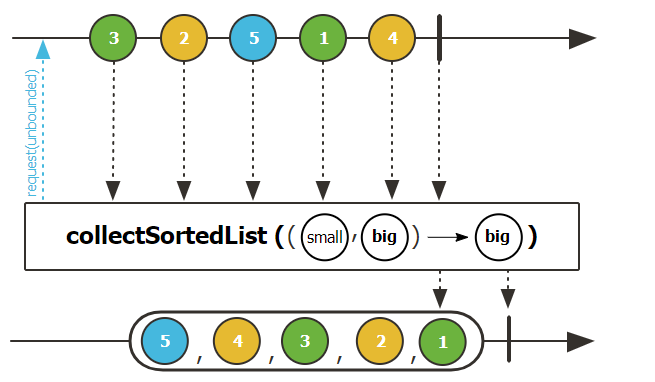
Flux.just(1, 3, 5, 3, 2, 5, 1, 4)
.collectSortedList()
.subscribe(System.out::println);
总结
本篇我们介绍了 Reactor 操作符的分类,之后介绍了部分转换类操作符,讲解示例时都是单个操作符,相信大家都能理解。
今天的内容就学到这里,我们下篇继续学习 Reactor 的操作符。
源码详见:https://github.com/crystalxmumu/spring-web-flux-study-note 下 02-reactor-core-learning 模块下 ReactorTransformOperatorTest 测试类。
参考
文档信息
- 本文作者:小飞猪
- 本文链接:https://crystalxmumu.github.io/2020/06/20/reactive-streams-reactor-learning-4th/
- 版权声明:自由转载-非商用-非衍生-保持署名(创意共享3.0许可证)
